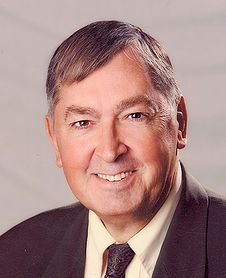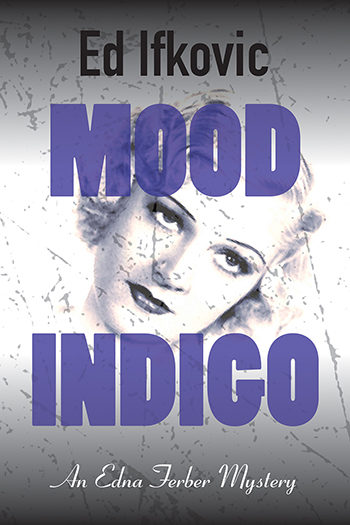Ed Ifkovic is the author of the Edna Ferber series, meticulously researched historical mysteries based on the life of the titular “largely forgotten American writer.” In an essay written exclusively for Bookreporter.com, Ifkovic gets into why he found Ferber so endlessly fascinating in the first place, as well as what drives his research and how it helps shape the series. Understanding his thought process and his enthusiasm will make reading his latest Edna Ferber mystery, MOOD INDIGO, all the more enjoyable.
 Edna Ferber and I go way back.
Edna Ferber and I go way back.
For years, I played around with the notion of bestselling author Ferber as an amateur sleuth in a series of mysteries. I read her CIMARRON when I was a kid, given the novel by my mother who read all of Ferber. Back then, I was the kind of avid reader who tackled every book by any author I discovered, so I prowled the local library for her books, from SHOW BOAT to SO BIG to her Broadway hit plays. But I knew of Ferber as a personality during my high-school years in New Haven --- a favorite teacher supposedly got into a screaming match with the writer at the Taft Hotel when Edna was in town during a tryout for one of her plays. I loved that story, apocryphal though it is. So I already held an image of a feisty, no-nonsense woman. As I read about her life in her autobiographies and in memoirs, various anecdotes caught my attention, intrigued me, and became the beginnings of plots. I’ve done nine mysteries so far. Any chance reading of an “Edna tidbit” gets my juices flowing. For example, a letter from Teddy Roosevelt to her during the 1912 Republican Convention in Chicago? Well, maybe a murder has to take place in that convention hall.
This is how MOOD INDIGO came about. I was reading a list of manuscripts on an auction site and spotted Noel Coward’s guest book for sale. Living in Manhattan, he threw lavish birthday/Christmas parties at his Beckman Place townhouse, all the guests signing in. Not only luminaries like Irving Berlin and Moss Hart, but also Edna Ferber, an old friend. And I thought: a wonderful party on a snowy winter evening --- the opening scene of Chapter One. Perhaps I should add a murder into the mix! Depression-era Manhattan, breadlines and apple vendors, even the legendary Automat. I’d once bought a sandwich at the old Times Square Automat, though many years later in its final days. With the strains of Duke Ellington’s mournful dirge in my ear, I began to invent another Edna mystery.
 In COLD MORNING, she covered the sensational kidnapping of aviator hero Charles Lindbergh’s baby and the subsequent trial of German immigrant Bruno Hauptmann, the “Trial of the Century” back in 1935. A full-blown media circus. The New York Times hired Ferber to cover the spectacle. She was well-known for her heartfelt depictions of simple American life, so the Times editors wanted the human-interest angle covered. The keen-eyed Ferber endured one day of the trial and was particularly horrified by the madness --- both inside the courtroom where crowds cheered Lindbergh and hissed at Hauptmann, but also outside, where throngs chanted anti-German slogans. Her one published column was a brutal, tough indictment of the scene. She left after one day, but I decided she needed to stay for the whole trial. Not only that, she also had another murder to solve!
In COLD MORNING, she covered the sensational kidnapping of aviator hero Charles Lindbergh’s baby and the subsequent trial of German immigrant Bruno Hauptmann, the “Trial of the Century” back in 1935. A full-blown media circus. The New York Times hired Ferber to cover the spectacle. She was well-known for her heartfelt depictions of simple American life, so the Times editors wanted the human-interest angle covered. The keen-eyed Ferber endured one day of the trial and was particularly horrified by the madness --- both inside the courtroom where crowds cheered Lindbergh and hissed at Hauptmann, but also outside, where throngs chanted anti-German slogans. Her one published column was a brutal, tough indictment of the scene. She left after one day, but I decided she needed to stay for the whole trial. Not only that, she also had another murder to solve!
The Ferber novels involve considerable research, which I love doing. Yes, I utilize the Internet, though I still prefer to surround myself with stacks of old books, sitting with a notepad as I jot down bits and pieces of arcane information about period clothing, social attitudes and historical quirks. When I’m doing an Edna book, I am totally immersed in the historical period I’m writing about --- I really want the reader to sense the temper of the time, understand how the era “looked,” consider how a particular moment in history contributes to her approach to the mystery. I become obsessed with facts: When was the first Nancy Drew book published? When did Prohibition end? Why did she forget her formal gloves when she met Hoover at the White House? What was Edna’s favorite remedy for a sore throat? (A discreet cocktail, if you must know.)
There is also a certain mindset I need in exploring Ferber’s world. Writing from the first-person singular point of view of a woman --- sometimes a young woman of 19, sometimes an old woman in her 70s, a celebrated woman at that --- I need to situate myself in that complicated mix. She was fiercely opinionated, suffered no fools, and I know she would have hated an upstart like me appropriating her life for a series of mystery novels! Though she is a largely forgotten American writer these days, I like to believe that she’d forgive my murderous appropriation of her life.


